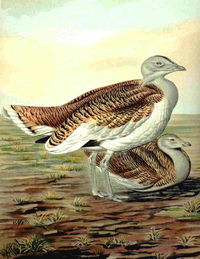Great Bustard
2007 Schools Wikipedia Selection. Related subjects: Birds
| iGreat Bustard | ||||||||||||||
|---|---|---|---|---|---|---|---|---|---|---|---|---|---|---|
 |
||||||||||||||
|
|
||||||||||||||
| Scientific classification | ||||||||||||||
|
||||||||||||||
|
|
||||||||||||||
| Otis tarda Linnaeus, 1758 |
The Great Bustard, Otis tarda, is in the bustard family, the only member of the genus Otis. It breeds in southern and central Europe and across temperate Asia. European populations are mainly resident, but Asian birds move further south in winter. It is the national bird of Hungary.
This species is declining due to habitat loss throughout its range. It used to breed more widely and was extinct in the British Isles between 1832 and an artificial reintroduction to Salisbury Plain in 2004. It was also found in the Bărăgan region of Romania, but went extinct in 1967.
The male of this huge bird is possibly the heaviest extant bird capable of flight, alongside the similarly-sized Kori Bustard. An adult male is normally 1.1 meters (3.7 feet) long with a 2.4 meter (7.9 foot) wingspan and an average weight of 13.5 kg (30 lb). The heaviest known bird was about 21 kg (46 lb), although larger specimens have been reported but not verified. An adult male is brown above and white below, with a long grey neck and head. The breast and lower neck sides are chestnut. In the breeding season, the male has long white neck bristles. In flight, the long wings show large areas of white.
The female is 30% smaller and half the weight, averaging 6.5 kg (14.3 lb). The breast and neck are buff. Both sexes are usually silent. Immature birds resemble the female.
The Great bustards breed in March, and a single male may mate with up to 5 females. Before mating, the male bustards moult into their breeding plumage around January. All breeding bustards moult from June to September as well. Males put on elaborate shows for the females; flashing their white under plumage and dancing around is the usual behaviour in attracting a female.
This species is omnivorous, taking seeds, insects and other small creatures, including frogs and beetles. Like other bustards, the male Great Bustard has a flamboyant display showing much white, mainly from the undertail, and withdrawing the head. 2-3 olive or tan coloured, glossy eggs are laid in a small scrape in the dirt. The female incubates the eggs by herself for around 4 weeks. The chicks almost immediately leave the nest after they hatch, although they don't move very far from their mother until they're at least 1 year old. Males usually start to mate from about 5 years old. Great bustards typically live for around 10 years, but some have been known to live up to 15 years or more.
This bird's habitat is open grassland, although it can be found on undisturbed cultivation. It has a stately slow walk, and tends to run when disturbed rather than fly. It is gregarious, especially in winter.
